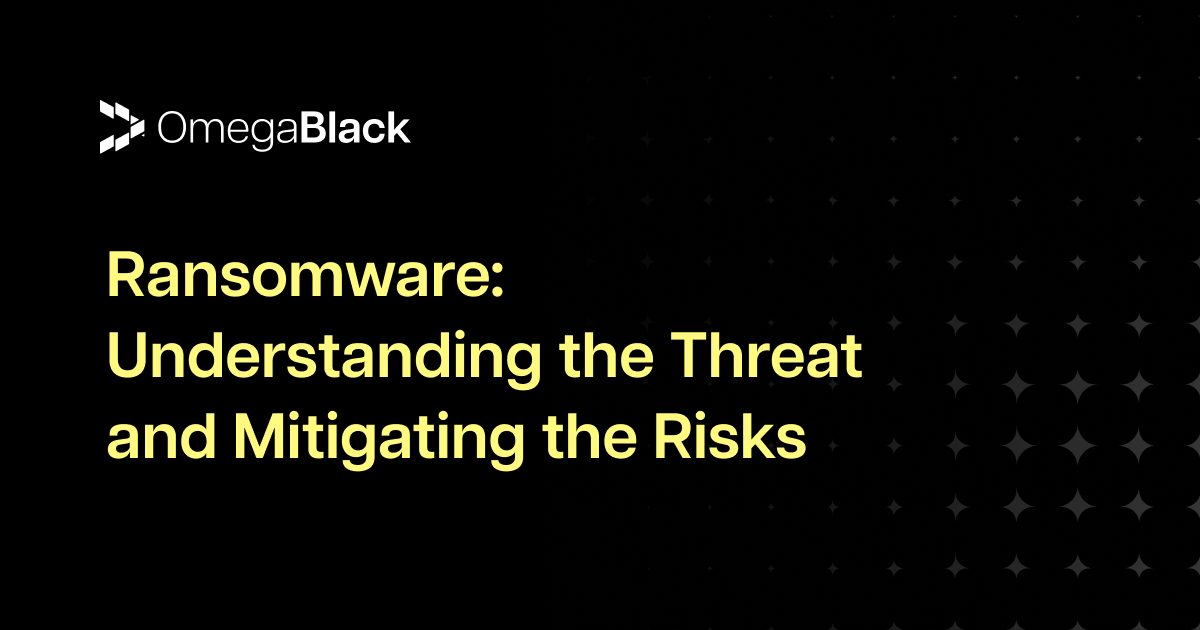Ransomware: Understanding the Threat and Mitigating the Risks

1. Introduction
Ransomware has rapidly become one of the most pervasive and dangerous threats in cybersecurity. Organizations of all sizes and sectors have been targeted, resulting in financial losses, data breaches, and significant operational disruptions. This type of malware is designed to encrypt or lock an organization's data, holding it hostage until a ransom is paid, usually in cryptocurrency. In this paper, we will explore how ransomware works, the evolution of ransomware tactics, notable incidents, and the strategies that organizations can adopt to mitigate the risks.
2. What is Ransomware
Ransomware is a type of malicious software that encrypts the files and systems of a victim, making them inaccessible until a ransom is paid to the attacker. Typically, cybercriminals demand payment in cryptocurrency, such as Bitcoin, to ensure anonymity and make it difficult for law enforcement to trace transactions.
Types of Ransomware:
- Locker Ransomware: This type locks users out of their systems, preventing access to the computer entirely, but it does not encrypt data. Attackers demand a ransom to restore access.
- Crypto Ransomware: The more common and dangerous form, crypto ransomware, encrypts files and data, making them unusable until a decryption key is provided.
- Scareware: A form of ransomware that preys on fear to coerce victims into paying a ransom. Unlike crypto or locker ransomware, scareware doesn't necessarily lock systems or encrypt data. Instead, it involves the use of fake security alerts or warnings that falsely claim that a device or system has been infected with malware or compromised. The victim is then prompted to pay a ransom or purchase fake antivirus software to "remove" the threat. This fake antivirus software is often malicious.
- Leakware (Double Extortion): A form of ransomware that threatens to leak data to the public or other third parties unless the ransom is paid.
- Ransomware-as-a-Service (RaaS): Like software-as-a-Service (SaaS), RaaS is a business model that allows cyber criminals to rent or purchase ransomware kits from developers. This makes ransomware widely available to less technically skilled attackers, and these affiliates of the RaaS often get a cut of the ransom paid.
- Wipers: These types of ransomware are different from the other types in that they threaten to destroy data if the victim does not pay the ransom. In some cases, the ransomware destroys the data regardless of if the victim pays. This type of ransomware/malware is usually deployed by nation-state actors or hacktivists rather than cybercriminals.
However, these types of ransomware are not mutually exclusive, meaning they can be combined or overlap in an attack. For example, a ransomware attack may involve both crypto ransomware, encrypting the victim's files, and leakware, threatening to release stolen data publicly if the ransom is not paid (double extortion). Additionally, attackers may use RaaS to distribute various forms of ransomware, allowing affiliates to leverage multiple techniques simultaneously to maximize their impact and chances of receiving payment.
3. Evolution of Ransomware Tactics
Ransomware has evolved significantly over the years, with attackers adopting new strategies to maximize their financial gain and impact on victims. Some of the key developments include:
3.1 Early Ransomware
The first known instance of ransomware dates back to 1989, known as the "AIDS Trojan" or "PC Cyborg." This early version encrypted files on a computer's hard drive and demanded a payment of $189 to restore access. However, the complexity and prevalence of ransomware attacks remained limited until the 2010s.
3.2 Ransomware-as-a-Service (RaaS)
In recent years, Ransomware-as-a-Service (RaaS) has emerged, where cybercriminals provide ransomware toolkits to affiliates in exchange for a share of the profits. This business model allows less technically skilled individuals to launch sophisticated ransomware attacks, leading to an explosion in the number of incidents. Prominent RaaS groups include LockBit, DarkSide, and CL0P.
3.3 Leakware (Double Extortion)
Leakware or Double extortion ransomware has become increasingly common. In this scenario, attackers not only encrypt the victim's data but also exfiltrate sensitive files. They threaten to release this information publicly or sell it on the dark web if the ransom is not paid, adding an additional layer of pressure on victims. Examples of double extortion attacks include the Sodinokibi/REvil attack on Travelex and the DoppelPaymer ransomware attack on healthcare providers.
3.4 Targeted Ransomware Attacks
While earlier ransomware campaigns focused on mass distribution (phishing emails, exploit kits, etc.), modern ransomware operators often target specific organizations. These targeted ransomware attacks are more sophisticated, with attackers conducting reconnaissance to exploit vulnerabilities and maximize the ransom payout. High-value targets such as healthcare organizations, critical infrastructure, and financial institutions are increasingly in the crosshairs.
4. Notable Ransomware Incidents
4.1 WannaCry (2017)
One of the most infamous ransomware attacks, WannaCry, struck in May 2017, affecting over 230,000 computers across 150 countries in just a few days. The ransomware exploited a vulnerability in Microsoft's SMB protocol, which had been publicly disclosed by the Shadow Brokers hacking group. WannaCry targeted healthcare institutions, financial services, and government agencies, with the UK's National Health Service (NHS) being one of the hardest-hit organizations. Estimated damages from the attack are believed to be in the billions of dollars.
4.2 Colonial Pipeline (2021)
In May 2021, a ransomware attack by the DarkSide group targeted Colonial Pipeline, a major fuel pipeline operator in the United States. The company had to shut down operations, leading to fuel shortages along the East Coast. Colonial Pipeline ultimately paid a ransom of approximately $4.4 million to regain access to its systems, although U.S. authorities were able to recover part of the payment later.
4.3 Kaseya VSA Attack (2021)
In July 2021, the REvil ransomware group exploited a vulnerability in Kaseya's VSA software, which is widely used by managed service providers (MSPs) to monitor and manage IT systems. This supply chain attack affected over 1,500 organizations worldwide, with REvil demanding a $70 million ransom for a universal decryption key. This attack illustrated the dangers of ransomware spreading through supply chain vulnerabilities.
5. Mitigating the Risks of Ransomware
Although ransomware remains a significant threat, organizations can take proactive steps to mitigate the risks and minimize the potential damage of an attack. The following strategies are essential to building resilience against ransomware:
5.1 Backup and Recovery Strategies
One of the most effective ways to combat ransomware is to maintain regular backups of critical data. These backups should be:
- Offline or air-gapped to prevent them from being encrypted by ransomware.
- Regularly tested to ensure data can be restored quickly in the event of an attack.
Having an effective backup and recovery plan can significantly reduce the impact of a ransomware attack by allowing an organization to restore its data without paying the ransom.
5.2 Patch Management
Many ransomware attacks, including WannaCry, exploit known vulnerabilities in software. Implementing a robust patch management process to keep software and systems up to date with the latest security patches is crucial in preventing ransomware attacks.
5.3 Endpoint Protection and Monitoring
Advanced endpoint detection and response (EDR) solutions are essential in detecting and mitigating ransomware before it spreads. These tools use behavioral analysis to identify unusual patterns associated with ransomware, such as rapid file encryption or unauthorized privilege escalation.
5.4 Security Awareness Training
Phishing remains one of the most common vectors for ransomware delivery. Organizations should invest in security awareness training for employees to help them recognize phishing emails and other social engineering tactics used by attackers to gain initial access.
5.5 Least Privilege and Network Segmentation
Implementing least privilege access ensures that users only have the permissions necessary to perform their job functions, limiting the scope of ransomware attacks. Additionally, network segmentation can prevent ransomware from moving laterally across systems and isolating compromised sections of the network.
5.6 Incident Response Planning
Organizations should have a well-defined incident response plan for ransomware attacks. This plan should include steps for:
- Isolating affected systems.
- Communicating with relevant stakeholders (internal teams, legal, external cybersecurity experts, etc.).
- Deciding whether to pay the ransom (although paying ransoms is discouraged as it encourages further attacks).
5.7 Cyber Insurance
As ransomware incidents grow, cyber insurance has become an important tool for organizations to manage financial risks. Cyber insurance policies often cover the costs associated with ransomware response, including ransom payments, legal fees, and recovery expenses.
6. Conclusion
Ransomware remains a potent threat in today's cybersecurity landscape, with attackers becoming more sophisticated in their tactics. Organizations must adopt a multi-layered approach to security, combining prevention, detection, and response strategies. By focusing on robust backup and recovery, effective patch management, and continuous monitoring, businesses can significantly reduce their exposure to ransomware and limit the damage of potential attacks. As the threat of ransomware continues to evolve, staying informed and prepared is key to minimizing risks and ensuring the confidentiality, integrity, and availability of critical systems and data.


